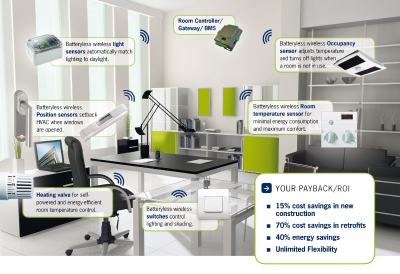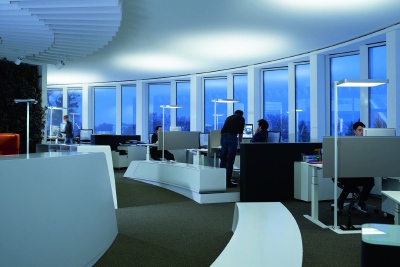The wireless way of lighting control
Modern lighting control not only enables interaction between lights, switches and sensors but also provides communication between individual lights themselves and a building automation system. Advances in wireless solutions bring increased flexibility and lower costs — as John Corbett of the EnOcean Alliance explains.
Lighting control is mandatory in today’s commercial buildings. It not only determines the level of illumination but needs to create a good working atmosphere that avoids so called ‘island lighting’. Many studies have shown that changing the characteristics of a white lamp can significantly influence human mood and productivity as well as modify the perception of the illuminated objects.
Retailers and shops were early to recognise that choosing the correct white colour temperature can help drive sales. Finally, intelligent lighting control is an important part of energy-saving measures by adapting illumination to specific situations without any intervention by humans.
 |
| Batteryless wireless devices can control a host of applications in an office space and save energy. |
The components of an intelligent lighting control are almost always the same.
• Lights
• Switches
• Sensors
• Controllers.
However, there are two ways to connect them— wired or wireless. Usually, in wired control systems the power delivery is separated from the control signals, allowing lower-cost electronic control solutions. This approach allows for wiring and control of individual lights or group of lights, as well as additional devices such as sensors. The lights communicate their status to the controller via feedback channels.
In a basic network, the same bus connects all lights, and a simple controller provides the same intensity for all lights. A more advanced system, for example DALI, based on more complex wiring and a powerful controller, can connect each light individually, define groups and set different levels of illumination.
However, in retrofit projects, the installation of wired control can be complex, costly and time-consuming. Modernising an existing building with wired control systems requires the addition of dedicated control cabling to each lamp and each additional element of the network, such as switches, sensors or lights. This can result in miles of conductors to be pulled through walls, which makes the planning and the installation more difficult. In addition, it is challenging to add to a system later on if requirements change.
Now, wireless control comes into play. It has increased in popularity in the last decade as a result of advances in radio technology and the emergence of standards that regulate communication between different devices. The key advantage of wireless control is the ease of upgrading existing buildings. No new control wiring is required for existing lights; rather they only have to be upgraded with wireless control units (actuators) which fit in the space of the existing connection. All other components, such as switches and sensors, can be wirelessly connected to the lights or a control unit by a one-time teach-in process. Additional devices can be added the same way at any time.
Wireless control systems can also provide greater installation flexibility if units such as sensors and switches work self-powered using energy-harvesting technology. These devices eliminate the issue of maintenance at the same time.
 |
| Wireless lighting control plays a key role in delivering efficiency, environmental friendliness and conversation of resources for the Center for Virtual Engineering ZVE in Germany. It uses free-standing luminaires from Waldmann with daylight and presence sensors. |
For lighting control, the two main energy sources for batteryless wireless devices are motion and light. Kinetic-powered switches generate a wireless signal for controlling and dimming. For powering occupancy sensors, for example, miniaturised solar cells harvest ambient light.
The wireless communication is based on the international standard ISO/IEC 14543-3-10 and standardised application profiles (EnOcean Equipment Profiles, EEP), which allow products from different vendors to be combined in a system. The range of the protocol is up to 30 m inside buildings. These characteristics make the ISO/IEC standard well suited for integrated wireless lighting control in buildings having a few hundred wireless sensor nodes up to several thousand.
The Fraunhofer IAO has implemented an integrated lighting system in its Center for Virtual Engineering ZVE in Germany. Wireless lighting control played a central role in the building’s concept of efficiency, environmental friendliness and conservation of resources. The flexible lighting solutions adjust to individual requirements depending on the working situation. It was achieved by free-standing luminaires from Waldmann that include a daylight sensor system, presence sensor technology and wireless group communication.
The luminaires automatically learn and communicate with one another via the EnOcean wireless ISO/IEC standard. That way, they can adapt their light output to change presence situations in the office. If the office is completely occupied, each workstation has individually set lighting levels. The lighting level is reduced to background lighting in the places where people are not present.
Using external batteryless wireless switches, users can turn on/off or dim certain luminaires. Additional self-powered wireless devices, such as occupancy and light-intensity sensors, can be integrated by using a gateway to connect the lighting system to a building-automation system. This also enables the use of presence and daylight information for the luminaires to control the HVAC system. With this integrated wireless lighting control, the Fraunhofer Institute significantly reduced the building’s energy consumption while maintaining a pleasant lighting atmosphere for the office staff. Owing to the wireless technology, the system’s intelligence could be realised with minimum installation effort.
John Corbett is business development director northern Europe of the EnOcean Alliance.








